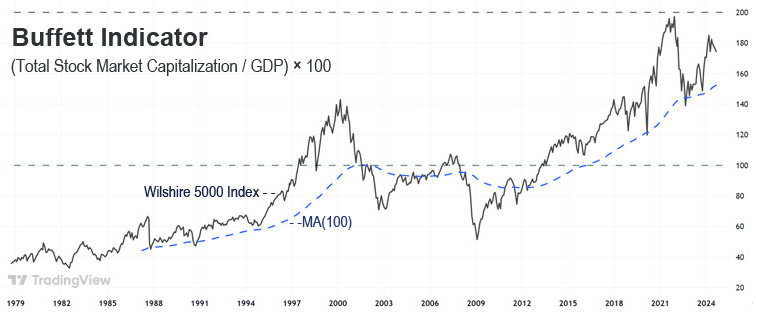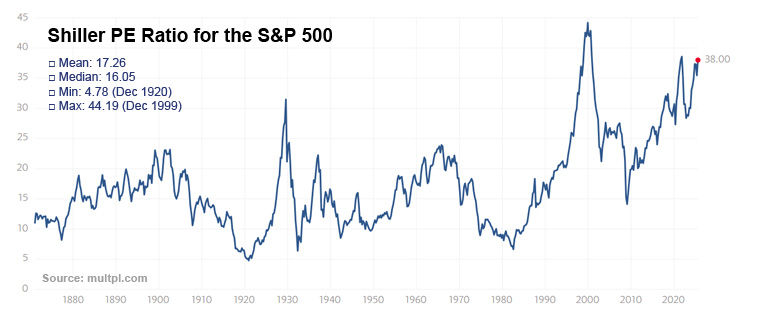P/E, PEG, Shiller P/E, and the Buffett Indicator

“Money, the denominator of every economic value, rapidly loses purchasing power due to inflation, driving equity prices higher and higher".
The stock market is widely seen as fundamentally overvalued by most analysts. This analysis examines how expensive stocks are today using several tools and indicators, and more specifically:
• Stock Market Capitalization to GDP (Buffett Indicator)
• Historical P/E ratios for S&P 500, Nasdaq 100, DAX 40, and NIFTY 50
• P/E/G Ratio for Nasdaq 100
• Historical Shiller P/E Ratio (CAPE) for S&P 500
🔢 Comparing Stock Evaluation Methods
Starting with the “Stock Market Capitalization to GDP,” which is based on the Wilshire 5000 Index, this measure gives a macroeconomic view of how expensive stocks are. Next, we look at valuations using the P/E, P/E/G, and Shiller P/E ratios.
|
INDICATOR |
FORMULA |
INSIGHT |
|
(Total Stock Market Capitalization / U.S. GDP) × 100 |
☑️ Long-Term Market Thesis |
|
Total Market Cap / Total Earnings |
☑️ Evaluating the Stock Market ☑️ Evaluating Most Industries |
|
(Total Market Cap / Total Earnings) / Earnings Growth Rate |
☑️ Evaluating Tech Stocks |
|
Market Cap / (Average Inflation-Adjusted Earnings) |
☑️ Evaluating the Stock Market ☑️ Evaluating Most Industries |
1️⃣ Stock Market Capitalization to GDP
Based on the Wilshire 5000 Index and U.S. GDP, the "Market Cap to GDP" ratio—also known as the Buffett Indicator—shows whether the overall stock market is overvalued or undervalued.
🧮 Buffett Indicator = (Total Stock Market Capitalization / U.S. GDP) × 100
Keep in mind that this indicator can be used to evaluate any stock market in the world.
A Historical View
The table below provides a historical view of total stock market capitalization to GDP ratios by decade.
Table: Total stock market capitalization to GDP ratios by decade
|
Decade |
Stock Market Cap to GDP Ratio (%) |
Short-Explanation |
|
30% – 70% |
In the 1980s, stock markets were less globalized, less driven by technology, and more focused on fundamentals. |
|
50% – 140% |
In the 1990s, stock markets became more globalized, and the rise of the internet pushed valuations further higher. |
|
50% – 140% |
The ratio declined throughout the 2000s, as the decade began with the Dot-com crash and ended with a major financial crisis. |
|
70% – 160% |
The ratio began to rise as the economy recovered, interest rates remained low, and tech giants boomed. |
|
120% – 190% |
In this current decade, economic stimulus and high inflation have pushed the ratio to historic highs. |
The following chart shows the historical values of the "Market Cap to GDP" ratio from 1979 to 2025.
Chart: Buffett Indicator and EMA(100)

An examination of the stock market’s fair valuation using the Buffett Indicator suggests that U.S. markets may be overvalued. However, the chart also shows a long-term uptrend, meaning investors are more willing to accept higher valuations than before. Note that bull markets often pull back to the EMA(100), so we could see a correction to around the 155-160 level while the bull market remains intact.
👉 The stock market could drop 12-18% and still keep the bull market alive.
2️⃣ Comprehensive Analysis of Historical P/E Ratios
As of early August 2025 (8/5/25), the table below shows the P/E ratios of major stock markets along with their deviations from historical averages.
Table: Stock Markets Around the Globe with Their P/E Ratios and Dividend Yields
|
Stock Market Index |
Current P/E |
10-Yr Avg P/E |
Deviation (Historical/Current) |
Dividend Yield |
Valuation |
|
28.8 |
19.3 |
+49% |
1.25% |
|
|
33.8 |
25.8 |
+31% |
0.71% |
|
|
19.6 |
13.4 |
+46% |
2.68% |
|
|
21.9 |
20.3 |
+8% |
1.38% |
|
👉 Current P/E ratios for most stock markets indicate overvaluation.
Notes
📌 Short-term P/E ratios can fluctuate widely due to earnings changes or market sentiment, while a long-term average smooths out these ups and downs.
📌 Many analysts use 5-year, 10-year, or even 20-year average P/E ratios to get a clearer view and reduce the effect of temporary market cycles.
P/E Variants:
Here are some common variations of the Price/Earnings ratio used by investors and analysts:
☑️ Trailing P/E: Based on the last 12 months of earnings
☑️ Forward P/E: Based on future earnings estimates
☑️ PEG Ratio: Adjusts the P/E ratio by factoring in expected earnings growth (explained below)
☑️ Cyclically Adjusted P/E (CAPE): Uses a 10-year average of inflation-adjusted earnings to smooth out economic cycles (explained below)
Historical P/E/G Ratios for Tech Stocks by Decade
The PEG Ratio (Price/Earnings to Growth) adjusts the traditional P/E ratio by considering a company’s expected earnings growth. It helps investors decide if a stock is fairly valued based on its growth potential.
🧮 PEG = (P/E Ratio) / (Earnings Growth Rate)
Table: P/E/G Ratios for Tech Stocks by Decade
|
Decade |
Typical P/E |
Typical P/E/G |
Explaining Technology Stocks' Valuations |
|
15 – 25 |
1.0 – 1.5 |
The decade that sparked the personal computing revolution, however, saw only modest growth expectations. |
|
25 – 45 |
1.5 – 3.0 |
The PC hardware manufacturing revolution, combined with the rise of Microsoft Windows and the introduction of retail internet access, led to the dot-com boom. |
|
20 – 40 |
1.1 – 2.5 |
The use of home computers and mobile devices surged; however, the Dot-com crash and the banking crisis of 2007-2008 helped stabilize tech valuations. |
|
20 – 50 |
1.3 – 2.5 |
Smartphone sales and the growth of cloud computing drive valuations higher. |
|
30 – 70 |
1.5 – 3.5 |
Cheaper smartphones and advances in artificial intelligence drive valuations to record highs. Low interest rates also play a supporting role. |
👉 Today, the P/E/G ratio for the Nasdaq 100 is 3.25, which suggests overvaluation.
👉 At the same time, the Forward P/E for the Nasdaq 100 is about 26.85, which is a more reasonable indicator.
3️⃣ Shiller P/E Ratio for the S&P 500
The Shiller Price-to-Earnings (P/E) Ratio, also called the CAPE Ratio (Cyclically Adjusted Price-to-Earnings), smooths earnings over a 10-year period to account for economic cycles. It helps assess if the market is overvalued or undervalued compared to historical averages.
🧮 Shiller P/E = Current Price / Average Inflation-Adjusted Earnings (last 10 years)
The Shiller ratio smooths out short-term earnings fluctuations, making it a widely used tool in macroeconomic and investment analysis.
Shiller P/E Ratio for the S&P 500
Chart: Shiller Price-to-Earnings (P/E) for the S&P 500 
👉 The Shiller Price-to-Earnings ratio for the S&P 500 is 38, indicating the market is overvalued.
Final Verdict –Don’t Underestimate How Inflation Erodes Investors’ Purchasing Power
It’s fair to say the stock market is both fundamentally and historically overvalued. P/E and P/E/G ratios are high, and dividend yields are relatively low. At the same time, forward P/E ratios appear more reasonable. Could the market correct? Yes, it could. Is a correction likely? Yes, it’s probable but not certain. What is the most likely outcome? The most likely outcome is a correction of about 10-12%, without entering a bear market this year.
Why the bull market will likely continue after a correction?
A simple reason is that persistent inflation reduces the purchasing power of money. It’s not just stocks that have risen this decade—gold, real estate, and even food prices have increased. Since money is the denominator of every value in the economy and is losing value, it’s no surprise that equity prices keep rising.
What to expect in the coming years?
The Trump administration focuses on boosting domestic production and economic growth through inflationary tariffs and tax cuts. Meanwhile, the Fed will start cutting interest rates sooner rather than later. Inflation is expected to persist, while interest rates won’t keep up with the loss of money’s purchasing power. As a result, investors will need to keep a large part of their portfolios in equities to protect against this loss.
This trend will continue until inflation eases and corporate profits begin to weaken—possibly sometime in 2026. When that happens, the stock market will enter a multi-month bear market. However, we are not there yet. For now, inflation remains, and corporate earnings are still strong.
■ Valuing the Stock Market with P/E, PEG, and Shiller P/E
Giorgos Protonotarios, Investment Analyst
for TradingCenter.org (c), August 6th, 2025
🔗 Sources:
- Longtermtrends.net/market-cap-to-gdp-the-buffett-indicator
- Multpl.com/shiller-pe
- PrimeInvestor.in/nifty-pe-ratio
- Worldperatio.com/area/germany
- SeekingAlpha.com
- Yale.edu
L MORE TUTORIALS • GENERAL GUIDES • TECHNICAL ANALYSIS
□ Equity Trading
» TD Sequential
» Wyckoff's Method
• FUNDAMENTAL ANALYSIS
» Money Supply & Liquidity
» Dow Theory & Strategy
» P/E, PEG, and Shiller P/E
» Warren Buffett’s Method
» Zweig Breadth Thrust Signal
» Benner’s Cycle
» Stock Market Formula
» MOVE Volatility Index



